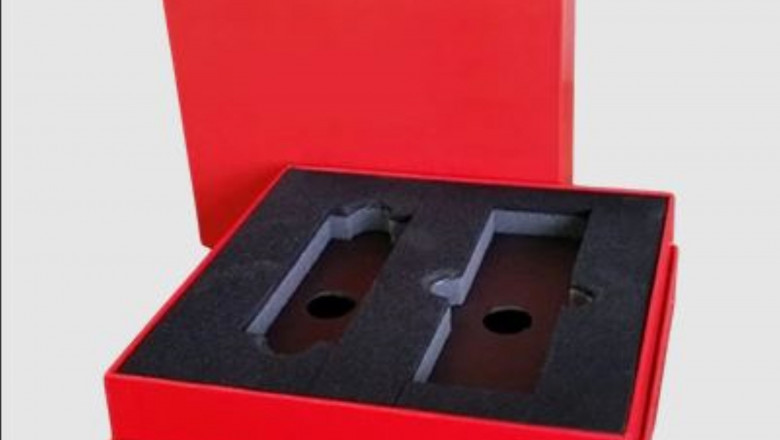views
Luxury Rigid Boxes vs. Other Packaging Options
Packaging plays a critical role in defining the customer experience and setting the tone for a product’s perceived value. While there are numerous packaging options available, luxury rigid boxes have emerged as a favorite in the premium market for their superior aesthetics and functional advantages. To understand their appeal, it’s essential to compare luxury rigid boxes with other popular packaging options, such as folding cartons, corrugated boxes, and flexible packaging. Here’s a detailed breakdown of how luxury rigid boxes fare against these alternatives.
1. Material Strength and Durability
Luxury rigid boxes are made from thick paperboard, often ranging from 1.5 mm to 3 mm in thickness, which gives them a sturdy and robust structure. This strength ensures that the box retains its shape and protects the product inside, even during transportation or extended storage. In contrast, folding cartons, while lightweight and cost-effective, are less durable and prone to deformation under pressure. Similarly, flexible packaging lacks the rigidity needed for delicate or high-value products. Corrugated boxes are sturdy but often lack the refined, polished look required for luxury items.
2. Visual and Tactile Appeal
The aesthetics of luxury rigid boxes are unparalleled. They can be customized with premium finishes such as matte or glossy lamination, foil stamping, embossing, and soft-touch coatings, offering a tactile experience that feels high-end. Folding cartons, while capable of vibrant printing, often lack the premium texture and structural presence of rigid boxes. Corrugated boxes prioritize functionality over aesthetics, making them unsuitable for luxury branding. Flexible packaging, while versatile, cannot achieve the same level of sophistication and elegance as rigid boxes.
3. Perceived Value and Brand Identity
Luxury rigid boxes enhance the perceived value of a product by creating an aura of exclusivity and quality. They communicate a brand’s commitment to excellence and attention to detail, making them ideal for high-end products like jewelry, cosmetics, and electronics. Folding cartons, while practical, often convey a sense of mass production. Corrugated boxes are better suited for bulk or industrial goods and lack the premium feel required for luxury branding. Flexible packaging, on the other hand, is more aligned with convenience and practicality rather than premium appeal.
4. Versatility in Design
Rigid boxes offer unparalleled design versatility, allowing for unique shapes, magnetic closures, ribbon pulls, and custom inserts that enhance the unboxing experience. This versatility makes them perfect for showcasing luxury items. Folding cartons, while adaptable, are limited in structural complexity and may not provide the same level of innovation. Corrugated boxes are functional but often lack the design sophistication needed for upscale products. Flexible packaging is highly adaptable but primarily serves utilitarian purposes, limiting its appeal for luxury markets.
5. Protection and Security
Luxury rigid boxes provide superior protection for products, thanks to their rigid structure and ability to incorporate custom inserts or padding. This makes them ideal for delicate items such as electronics or glassware. Folding cartons, though lightweight and convenient, may not provide adequate protection for fragile or high-value items. Corrugated boxes are highly protective but often too bulky for premium product presentations. Flexible packaging offers minimal protection and is better suited for lightweight or non-fragile items.
6. Sustainability and Reusability
Luxury rigid boxes are often designed to be reusable, adding value beyond the initial purchase. Many brands are also incorporating sustainable materials like recycled paperboard or biodegradable coatings into their rigid box designs. Folding cartons and corrugated boxes are recyclable but not typically reusable due to their lack of durability. Flexible packaging, while lightweight and efficient, is often less environmentally friendly because of its use of mixed materials that are harder to recycle.
7. Cost Considerations
Luxury rigid boxes are undoubtedly more expensive than folding cartons, corrugated boxes, and flexible packaging. However, this cost is justified by the premium experience and added value they bring to the product. Folding cartons are the most cost-effective option but are better suited for high-volume, low-cost products. Corrugated boxes are moderately priced but are typically reserved for industrial or bulk shipping purposes. Flexible packaging is affordable and practical but falls short in creating a luxury impression.
8. Customer Experience and Unboxing
Rigid boxes are designed to create an unforgettable unboxing experience, with features like magnetic closures, elegant interiors, and personalized touches that resonate with customers. This makes them a go-to choice for brands that want to make a strong emotional connection with their audience. Folding cartons, while practical, lack the wow factor of a well-designed rigid box. Corrugated boxes prioritize functionality over presentation, and flexible packaging offers little in terms of an engaging unboxing experience.
Conclusion
Luxury rigid boxes stand out as the ultimate choice for premium products, offering unmatched durability, aesthetic appeal, and versatility. While other packaging options like folding cartons, corrugated boxes, and flexible packaging have their strengths, they often fall short in conveying the exclusivity and sophistication required for high-end branding. By investing in luxury rigid boxes, brands can elevate their packaging, enhance the customer experience, and reinforce their identity in the competitive luxury market.























Comments
0 comment